Comparative Study Assessing the Relative Contributions of Ship Resistance Factors Based on Data Analysis
Abstract
:1. Introduction
2. Materials and Methods
2.1. Experimental Conditions
2.2. Single Factor Influence Analysis of Ship Resistance
2.3. Correlation Analysis of Multiple Factors of Ship Resistance
3. Results and Discussion
3.1. Response Surface Method
3.2. Analysis of Variance
3.3. Response Surface Results Analysis
4. Conclusions
- There is a significant positive correlation between ship resistance and speed, which conforms to the exponential equation change law. The ship resistance also gradually increases with increasing speed. Ship speed, displacement, and appendages can all have impacts on ship resistance, in which speed is the most important factor, and displacement has a greater impact than ship appendages.
- According to the correlation analysis, the maximum correlation coefficient between ship speed and resistance or power is 0.99. The correlation between displacement and ship resistance or power is much greater than that of appendages. The correlation analysis further proves the degree of influence of each factor on ship resistance.
- Actual ship power and speed, displacement, and appendage form a quadratic polynomial relationship. The multi-factor interaction analysis results show that speed and displacement have the greatest influence on actual ship power. The main reference factors in the selection of marine power equipment are speed and displacement.
Author Contributions
Funding
Institutional Review Board Statement
Informed Consent Statement
Data Availability Statement
Acknowledgments
Conflicts of Interest
References
- Yu, J.; Kim, S.; Jeong, W.; Kim, Y.; Choi, J.; Lee, N. Prediction of resistance and propulsion performances using calm-water and resistance tests in regular head waves of a 1800 TEU container ship. Int. J. Nav. Archit. Ocean Eng. 2022, 14, 100458. [Google Scholar] [CrossRef]
- IMO. Strategy on Reduction of GHG Emissions from Ships; MEPC.304(72); IMO: London, UK, 2018. [Google Scholar]
- IMO. Guidelines on the Method of Calculation of the Attained Energy Efficiency Existing Ship Index (EEXI); MEPC.333(76); IMO: London, UK, 2021. [Google Scholar]
- IPCC. Climate Change 2022: Mitigation of Climate Change; Contribution of Working Group III to the Sixth Assessment Report of the Intergovernmental Panel on Climate Change; Cambridge University Press: Cambridge, UK; New York, NY, USA, 2022. [Google Scholar]
- Kim, Y.; Steen, S.; Kramel, D.; Muri, H.; Strømman, A. Modelling of ship resistance and power consumption for the global fleet: The MariTEAM model. Ocean Eng. 2023, 281, 114758. [Google Scholar] [CrossRef]
- Samuel; Trimulyono, A.; Manik, P.; Chrismianto, D. A Numerical Study of Spray Strips Analysis on Fridsma Hull Form. Fluids 2021, 6, 420. [Google Scholar] [CrossRef]
- Trimulyono, A.; Hakim, M.L.; Ardhan, C.; Ahmad, S.T.P.; Tuswan, T.; Santosa, A.W.B. Analysis of the double steps position effect on planing hull performances. Brodogradnja 2023, 74, 41–72. [Google Scholar] [CrossRef]
- Ravenna, R.; Song, S.; Shi, W.; Sant, T.; Muscat-Fenech, C.; Tezdogan, T.; Demirel, Y. CFD analysis of the effect of heterogeneous hull roughness on ship resistance. Ocean Eng. 2022, 258, 111733. [Google Scholar] [CrossRef]
- Song, S.; Kim, D.; Demirel, Y.; Yang, J. An advanced prediction method of ship resistance with heterogeneous hull roughness. Ocean Eng. 2023, 279, 114602. [Google Scholar] [CrossRef]
- Song, S.; Terziev, M.; Tezdogan, T.; Demirel, Y.; Muscat-Fenech, C.; Incecik, A. Investigating roughness effects on ship resistance in shallow waters. Ocean Eng. 2023, 270, 113643. [Google Scholar] [CrossRef]
- Terziev, M.; Tezdogan, T.; Incecik, A. A geosim analysis of ship resistance decomposition and scale effects with the aid of CFD. Appl. Ocean Res. 2019, 92, 101930. [Google Scholar] [CrossRef]
- Liu, S.; Papanikolaou, A. Improvement of the prediction of the added resistance in waves of ships with extreme main dimensional ratios through numerical experiments. Ocean Eng. 2023, 273, 113963. [Google Scholar] [CrossRef]
- Bilgili, L. Determination of the weights of external conditions for ship resistance. Ocean Eng. 2023, 276, 114141. [Google Scholar] [CrossRef]
- Mittendorf, M.; Nielsen, U.; Bingham, H. Data-driven prediction of added-wave resistance on ships in oblique waves—A comparison between tree-based ensemble methods and artificial neural networks. Appl. Ocean Res. 2022, 118, 102964. [Google Scholar] [CrossRef]
- Le, T.; Vu, M.; Bich, V.; Phuong, N.; Ha, N.; Chuan, T.; Tu, T. Numerical investigation on the effect of trim on ship resistance by RANSE method. Appl. Ocean Res. 2021, 111, 102642. [Google Scholar] [CrossRef]
- Campbell, R.; Terziev, M.; Tezdogan, T.; Incecik, A. Computational fluid dynamics predictions of draught and trim variations on ship resistance in confined waters. Appl. Ocean Res. 2022, 126, 103301. [Google Scholar] [CrossRef]
- Zou, Y.; Zhou, X.; Chen, L.; Xi, X. Impacts of different characteristics of marine biofouling on ship resistance. Ocean Eng. 2023, 278, 114415. [Google Scholar] [CrossRef]
- Farkas, A.; Degiuli, N.; Martić, I. An investigation into the effect of hard fouling on the ship resistance using CFD. Appl. Ocean Res. 2020, 100, 102205. [Google Scholar] [CrossRef]
- García, S.; Trueba, A.; Boullosa-Falces, D.; Islam, H.; Soares, C. Predicting ship frictional resistance due to biofouling using Reynolds-averaged Navier-Stokes simulations. Appl. Ocean Res. 2020, 101, 102203. [Google Scholar] [CrossRef]
- Jeong, S.; Choi, K.; Kang, K.; Ha, J. Prediction of ship resistance in level ice based on empirical approach. Int. J. Nav. Archit. Ocean Eng. 2017, 9, 613–623. [Google Scholar] [CrossRef]
- Guo, W.; Zhao, Q.; Tian, Y.; Zhang, W. Research on total resistance of ice-going ship for different floe ice distributions based on virtual mass method. Int. J. Nav. Archit. Ocean Eng. 2020, 12, 957–966. [Google Scholar] [CrossRef]
- Yang, B.; Sun, Z.; Zhang, G.; Wang, Q.; Zong, Z.; Li, Z. Numerical estimation of ship resistance in broken ice and investigation on the effect of floe geometry. Mar. Struct. 2021, 75, 102867. [Google Scholar] [CrossRef]
- Huang, L.; Li, Z.; Ryan, C.; Ringsberg, J.; Pena, B.; Li, M.; Ding, L.; Thomas, G. Ship resistance when operating in floating ice floes: Derivation, validation, and application of an empirical equation. Mar. Struct. 2021, 79, 103057. [Google Scholar] [CrossRef]
- Liu, T.; Lin, B.; Zhen, C.; Zou, Q.; Zhu, C.; Yan, F. Influence of coupled effect among flaw parameters on strength characteristic of precracked specimen: Application of response surface methodology and fractal method. J. Nat. Gas Sci. Eng. 2015, 26, 857–866. [Google Scholar] [CrossRef]
- Sodeifian, G.; Azizi, J.; Ghoreishi, S. Response surface optimization of Smyrnium cordifolium Boiss (SCB) oil extraction via supercritical carbon dioxide. J. Supercrit. Fluids 2014, 95, 1–7. [Google Scholar] [CrossRef]
- Kirmizakis, P.; Tsamoutsoglou, C.; Kayan, B.; Kalderis, D. Subcritical water treatment of landfill leachate: Application of response surface methodology. J. Environ. Manag. 2014, 146, 9–15. [Google Scholar] [CrossRef]
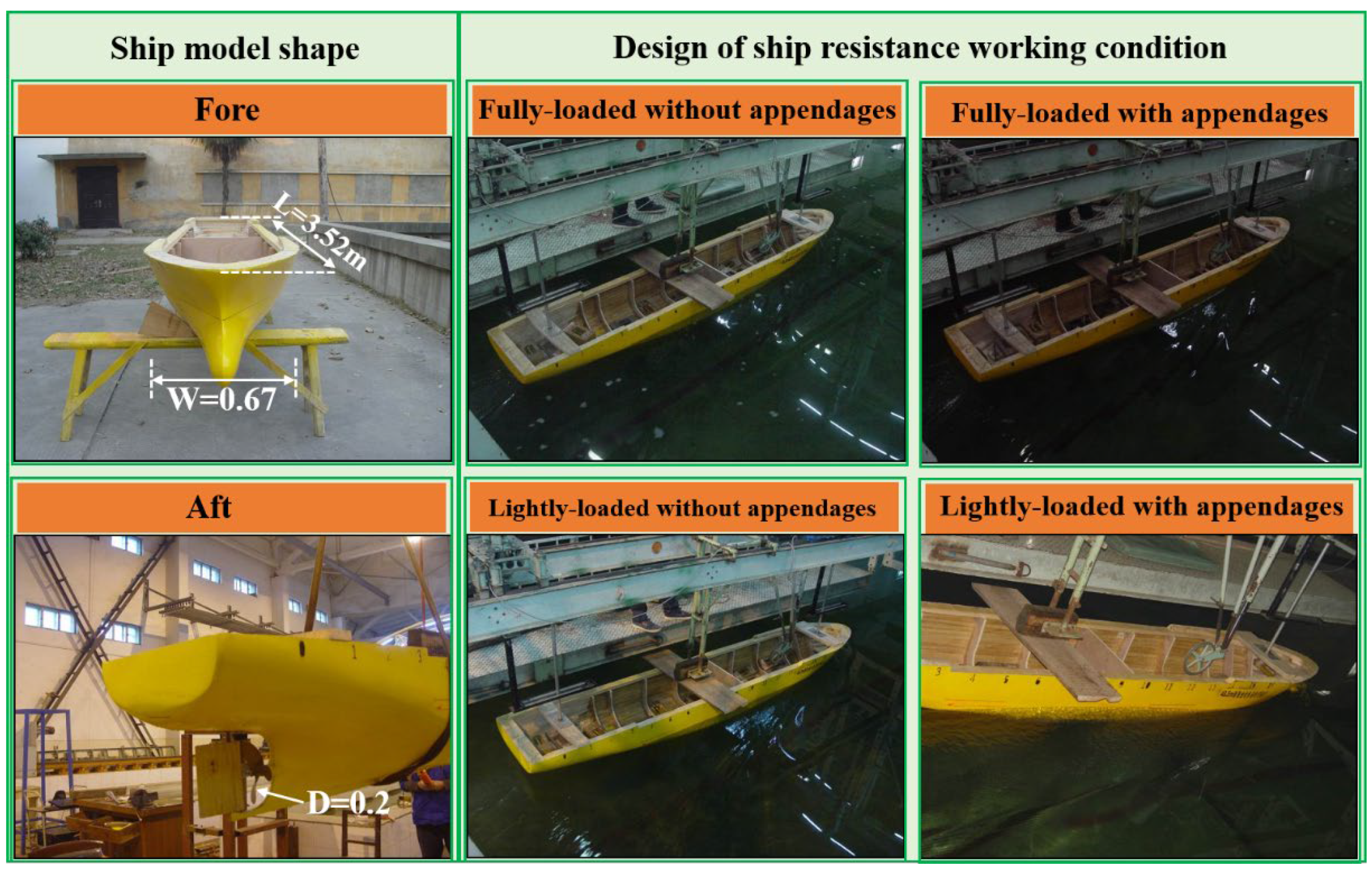
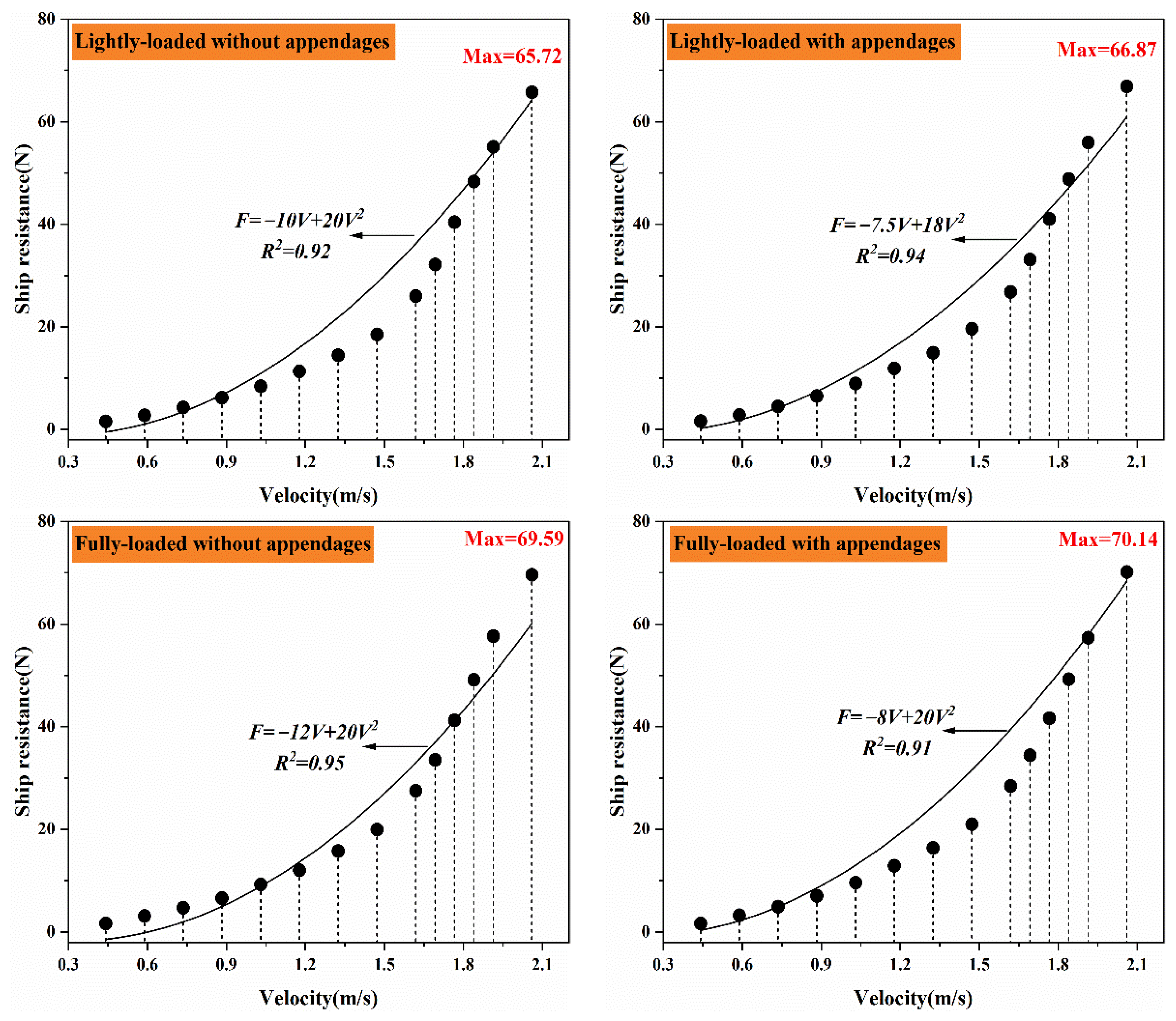
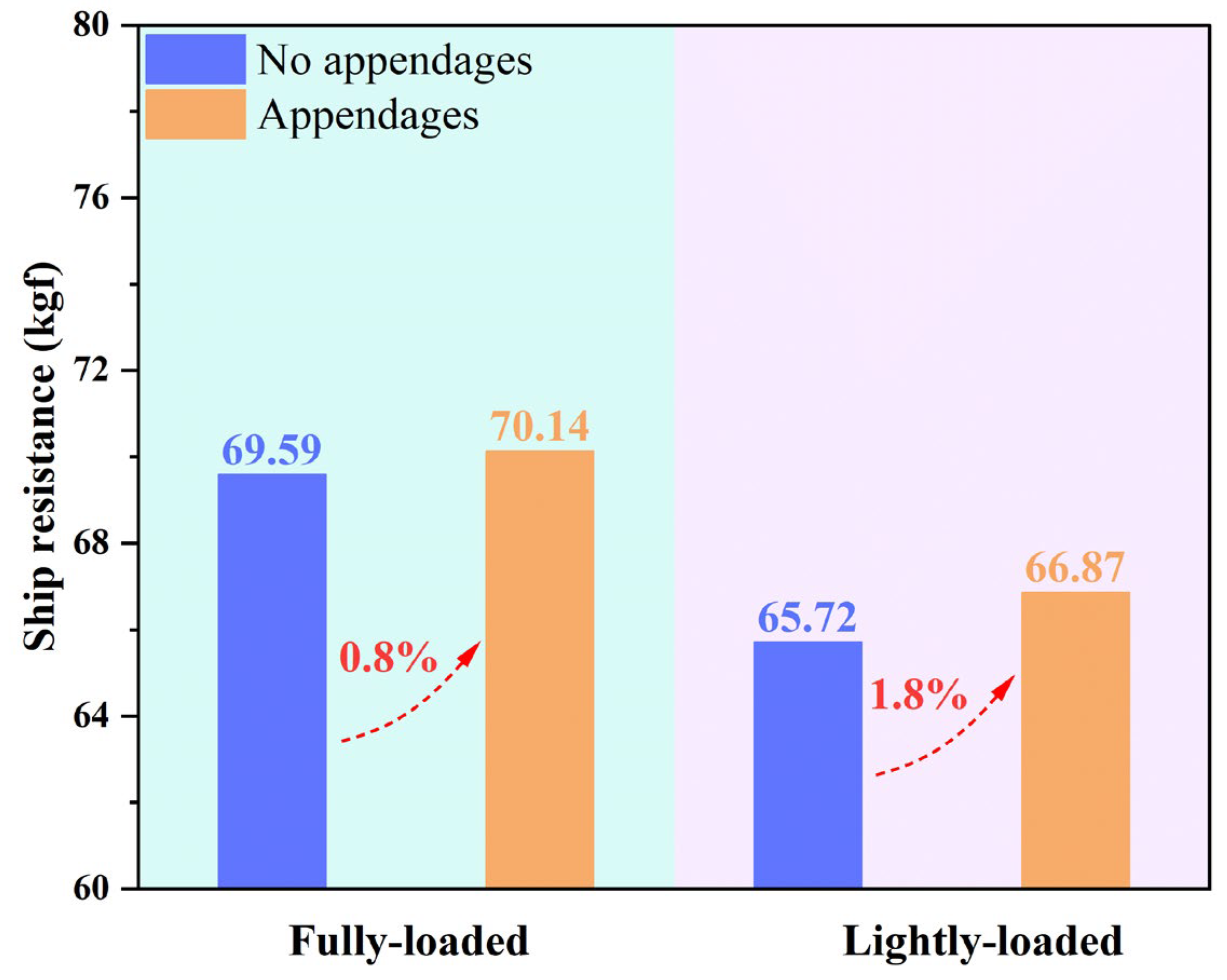
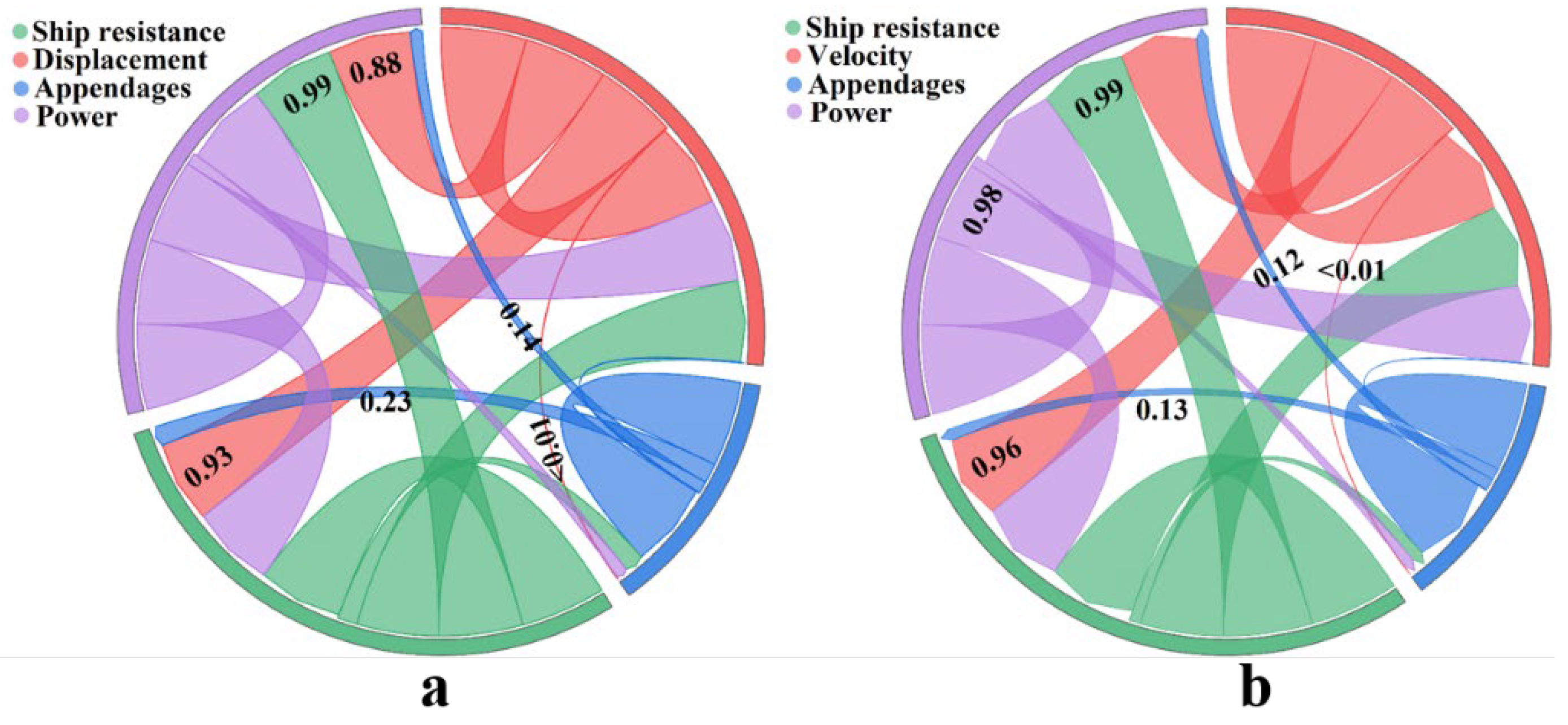
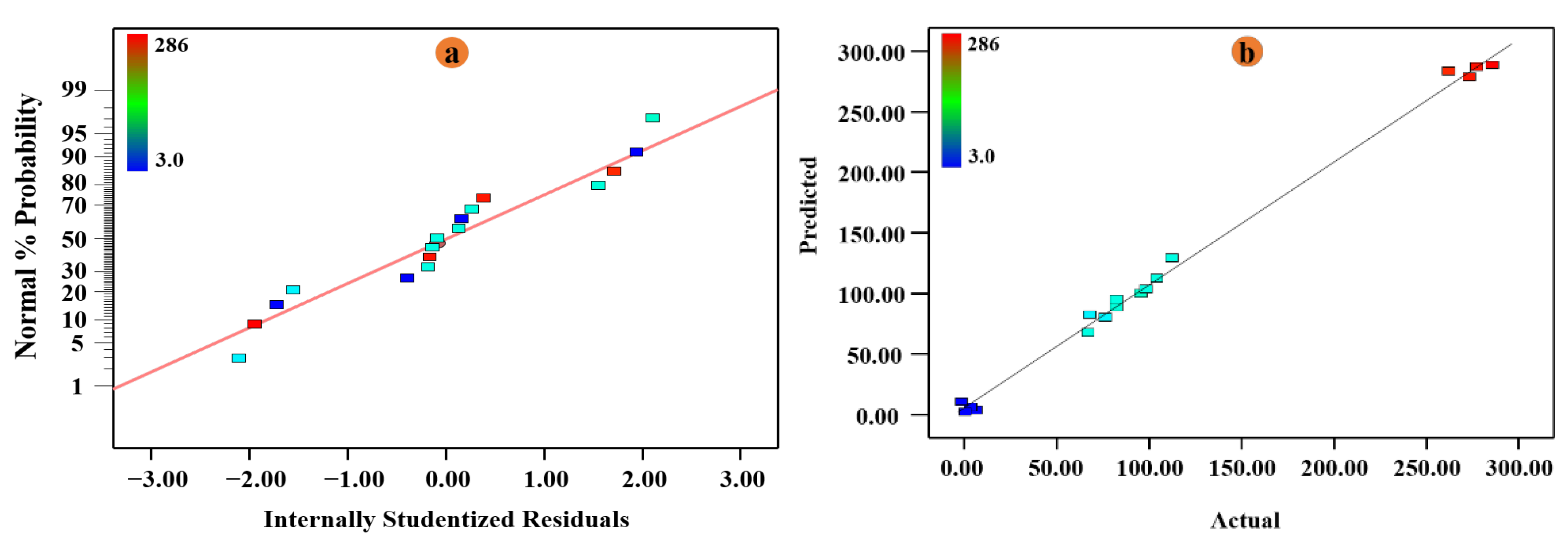
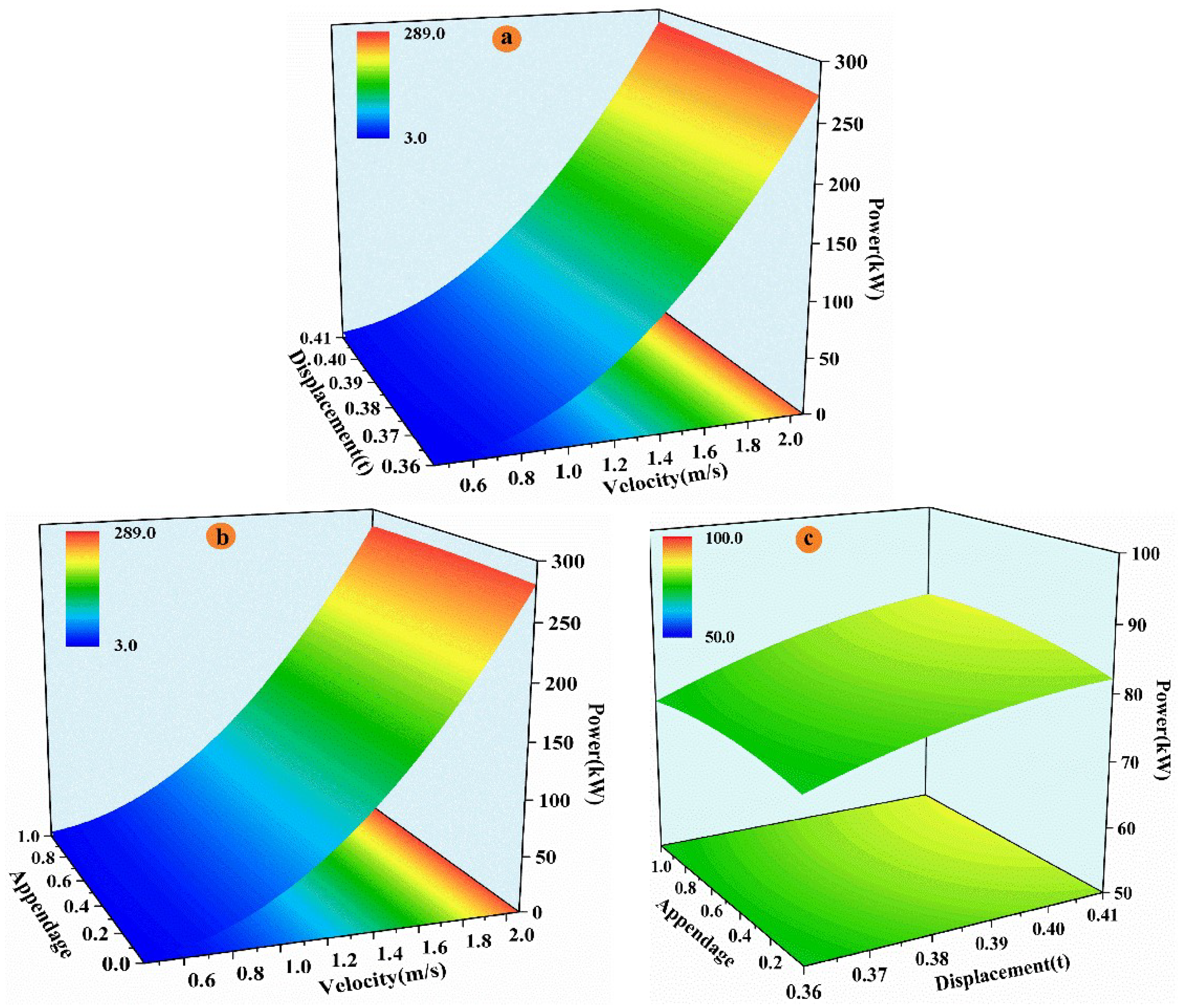
| Parameter | Unit | Lightly Loaded | Fully Loaded | ||
|---|---|---|---|---|---|
| Model Ship | Actual Ship | Model Ship | Actual Ship | ||
| Waterline length | m | 3.7435 | 45.75 | 3.7571 | 45.92 |
| Length between perpendiculars | m | 3.5182 | 43.00 | 3.5182 | 43.00 |
| Waterline breadth | m | 0.6709 | 8.20 | 0.6709 | 8.20 |
| Draft | m | 0.2250 | 2.75 | 0.2536 | 3.10 |
| Displacement | t | 0.3687 | 694.20 | 0.4150 | 781.25 |
| Surface block coefficient | -- | 0.6949 | 0.6949 | 0.6937 | 0.6937 |
| Propeller diameter | m | 0.2046 | 2.5 | 0.2046 | 2.5 |
| Scale ratio | m | 12.2222 | |||
| Power of the main engine | kW | 900 | |||
| Speed of rotation | rpm | 232 | |||
| Speed of Actual Ship (Kn) | Speed of Ship Model (m/s) | Re | Speed of Actual Ship (Kn) | Speed of Ship Model (m/s) | Re |
|---|---|---|---|---|---|
| 3.0 | 0.4415 | 1.34 × 106 | 10.0 | 1.4715 | 4.48 × 106 |
| 4.0 | 0.5886 | 1.79 × 106 | 11.0 | 1.6187 | 4.93 × 106 |
| 5.0 | 0.7358 | 2.24 × 106 | 11.5 | 1.6922 | 5.15 × 106 |
| 6.0 | 0.8829 | 2.67 × 106 | 12.0 | 1.7658 | 5.37 × 106 |
| 7.0 | 1.0301 | 3.13 × 106 | 12.5 | 1.8394 | 5.6 × 106 |
| 8.0 | 1.1772 | 3.58 × 106 | 13.0 | 1.9130 | 5.82 × 106 |
| 9.0 | 1.3244 | 4.03 × 106 | 14.0 | 2.0601 | 6.27 × 106 |
| Level | Velocity (m/s) (x) | Displacement (t) (y) | Appendage (z) |
|---|---|---|---|
| −1 | 0.44 | 0.36 | 0 |
| 0 | 1.25 | 0.385 | 0.5 |
| 1 | 2.06 | 0.41 | 1 |
| Source | Degrees of Freedom | F Value | p Value Prob > F |
|---|---|---|---|
| Model | 9 | 98.53 | <0.0001 |
| x | 1 | 242.97 | <0.0001 |
| y | 1 | 33.25 | 0.0007 |
| z | 1 | 19.4 | 0.003 |
| xy | 1 | 4.51 | 0.031 |
| xz | 1 | 15 | 0.0047 |
| yz | 1 | 42 | <0.0001 |
| x2 | 1 | 25.26 | 0.001 |
| y2 | 1 | 18.9 | 0.0043 |
| z2 | 1 | 9.15 | 0.034 |
| R2 = 0.9819, R2adj = 0.9494, R2pred = 0.9159, Adequate Precision = 94.03 | |||
Disclaimer/Publisher’s Note: The statements, opinions and data contained in all publications are solely those of the individual author(s) and contributor(s) and not of MDPI and/or the editor(s). MDPI and/or the editor(s) disclaim responsibility for any injury to people or property resulting from any ideas, methods, instructions or products referred to in the content. |
© 2023 by the authors. Licensee MDPI, Basel, Switzerland. This article is an open access article distributed under the terms and conditions of the Creative Commons Attribution (CC BY) license (https://creativecommons.org/licenses/by/4.0/).
Share and Cite
Zhao, X.; Li, N.; Zhang, B.; Liu, X. Comparative Study Assessing the Relative Contributions of Ship Resistance Factors Based on Data Analysis. Appl. Sci. 2023, 13, 13073. https://doi.org/10.3390/app132413073
Zhao X, Li N, Zhang B, Liu X. Comparative Study Assessing the Relative Contributions of Ship Resistance Factors Based on Data Analysis. Applied Sciences. 2023; 13(24):13073. https://doi.org/10.3390/app132413073
Chicago/Turabian StyleZhao, Xinying, Na Li, Bin Zhang, and Xiaolei Liu. 2023. "Comparative Study Assessing the Relative Contributions of Ship Resistance Factors Based on Data Analysis" Applied Sciences 13, no. 24: 13073. https://doi.org/10.3390/app132413073





